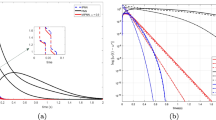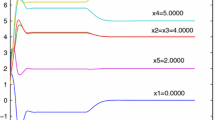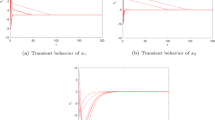Abstract
Since the neural network model may be affected by the impulse, a projection neural network(PNN) model with impulsive effect, named impulsive projection neural network(IPNN), is proposed in this paper. The IPNN can solve the variational inequalities and related optimization problems much faster than the PNN. We obtain the stability of the IPNN in two steps. Firstly, we construct a Lyapunov function to prove the stability of the PNN. Secondly, we prove that the Lyapunov function is non-increasing under the influence of impulsive effect. Finally, we give three simulation examples to show the performance of the IPNN.








Similar content being viewed by others
References
Bazaraa MS, Sherali HD, Shetty CM (1994) Nonlinear Programming: Theory and Algorithms
Cichocki A, Amari SI (2002) Adaptive Blind Signal and Image Process- ing: Learning Algorithms and Applications. John Wiley & Sons Inc
Mandic DP, Golz M, Kuh A, Obradovic D, Tanaka T (2008) Signal processing techniques for knowledge extraction and information fusion. Springer-Verlag New York, NY USA
Cheung YM, Xu L (2003) Dual multivariate auto-regressive modeling in state space for temporal signal separation, EEE transactions on systems, man, and cybernetics. Part B, Cybernetics: a publication of the IEEE Systems, Man, and Cybernetics Society 33(3):386–398
Bensoussan A, Chandrasekaran K, Turi J (1984) Optimal control of variational inequalities, The 23rd IEEE conference on decision and control 249–251
Ito K, Kunisch K (2010) Optimal control of parabolic variational inequalities. Journal de Mathématiques Pures et Appliquées 93(4):329–360
Kamil H, Anna J (2002) Optimal control and approximation of variational inequalities. Kybernetes 31(9/10):1401–1408
Cichocki A, Unbehauen R (1993) Neural networks for optimization and signal processing. wiley, New York
Hopfield JJ, Tank DW (1985) Neural computation of decisions in optimization problems. Biological Cybernetics 52:141–152
Hopfield JJ, Tank DW (1988) Simple “Neural” optimization networks: an A/D converter, signal decision circuit, and a linear programming circuit. Artificial neural networks: theoretical concepts 33(5):87–95
Kennedy MP, Chua LO (1988) Neural networks for nonlinear programming. IEEE Transactions on Circuits and Systems 35(5):554–562
Xia Y, Feng G, Wang J (2008) A novel recurrent neural network for solving nonlinear optimization problems with inequality constraints. IEEE Transactions on Neural Networks 19(8):1340–1353
Qin S, Liu Y, Xue X, Wang F (2016) A neurodynamic approach to convex optimization problems with general constraint. Neural networks: the official journal of the International Neural Network Society 84:113–124
Zhang S, Xia Y, Zheng W (2015) A complex-valued neural dynamical optimization approach and its stability analysis. Elsevier Science Ltd. 61:59–67
Qin S, Wei B, Xue X (2013) A new one-layer recurrent neural network for nonsmooth pseudoconvex optimization. Neurocomputing 120(23):655–662
Liu Q, Cao J (2005) Globally projected dynamical system and its applications. neural information processing letters & reviews 7(1):1–9
Xia Y, Wang J (2002) A projection neural network and its application to constrained optimization problems. IEEE Trans. Circuits Syst. II(49):447–458
Xia Y, Wang J (2004) A general projection neural network for solving monotone variational inequalities and related optimization problems. IEEE Transactions on Neural Networks 15(2):318–328
Che HJ, Wang J (2019) A collaborative neurodynamic approach to global and combinatorial optimization. Neural Netw 114:15–27
Liu N, Qin S (2019) A neurodynamic approach to nonlinear optimization problems with affine equality and convex inequality constraints. Neural Netw 109:147–158
Liu Q, Yang S, Wang J (2016) A collective neurodynamic approach to distributed constrained optimization. IEEE Transactions on Neural Networks and Learning Systems 28(8):1747–1758
Li C, Feng G, Huang T (2008) On hybrid impulsive and switching neural networks, IEEE Transactions on Systems, Man and Cybernetics. Part B (Cybernetics) 38(6):1549–1560
Song Q, Cao J (2007) Impulsive effects on stability of fuzzy Cohen-Grossberg neural networks with time-varying delays. IEEE Transactions on Systems Man & Cybernetics Part B Cybernetics A Publication of the IEEE Systems Man & Cybernetics Society 37(3):733–741
Guan ZH, Chen G (1999) On delayed impulsive Hopfield neural networks. Neural Netw 12(2):273–280
Chen J, Cui B (2008) Impulsive effects on global asymptotic stability of delay BAMneural networks. Chaos, Solitons & Fractals 38(4):1115–1125
Li C, Wu S, Feng GG, Liao X (2011) Stabilizing effects of impulses in discrete-time delayed neural networks. IEEE Transactions on Neural Networks 22(2):323–329
Mirzaee H (2009) Linear combination rule in genetic algorithm for optimization of finite impulse response neural network to predict natural chaotic time series. Chaos Solitons & Fractals 41(5):2681–2689
Kinderlehrer D, Stampacchia G (2000) An introduction to variational inequalities and their applications, SIAM
Boyd S, Vandenberghe L (2004) Convex optimization. Cambridge University Press
Acknowledgements
This work is supported by Foundation of Chongqing Municipal Key Laboratory of Institutions of Higher Education ([2017]3), Joint Training Base Construction Project for Graduate Students in Chongqing(JDLHPYJD2021016), Foundation of Chongqing Development and Reform Commission (2017[1007]), National Natural Science Foundation of China under Grants 61773004, Team Building Project for Graduate Tutors in Chongqing under Grants JDDSTD201802, Group Building Scientific Innovation Project for universities in Chongqing CXQT21021 and the Venture & Innovation Support Program for Chongqing Overseas Returnees under Grant cx2019127.
Author information
Authors and Affiliations
Corresponding author
Additional information
Publisher's Note
Springer Nature remains neutral with regard to jurisdictional claims in published maps and institutional affiliations.
Rights and permissions
About this article
Cite this article
Chen, J., Hu, J., Onasanya, B.O. et al. Stability Analysis of the Impulsive Projection Neural Network. Neural Process Lett 55, 645–656 (2023). https://doi.org/10.1007/s11063-022-10901-x
Accepted:
Published:
Issue Date:
DOI: https://doi.org/10.1007/s11063-022-10901-x




